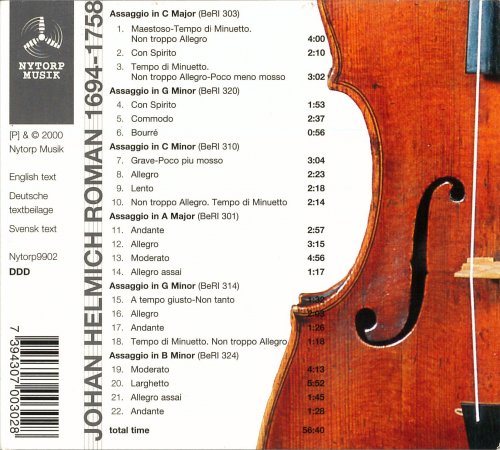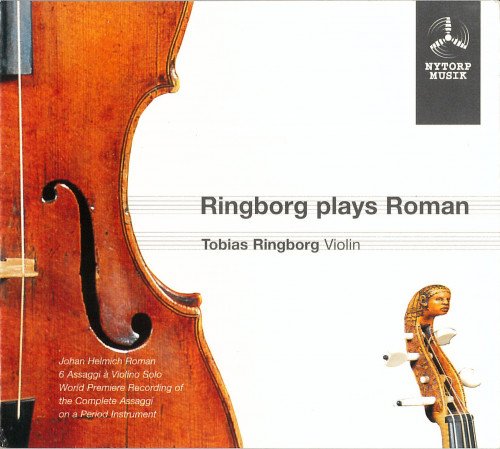
Tobias Ringborg - Johan Helmich Roman: Solo Violin Works (2000)
BAND/ARTIST: Tobias Ringborg
- Title: Johan Helmich Roman: Solo Violin Works
- Year Of Release: 2000
- Label: Nytorp Music
- Genre: Classical
- Quality: FLAC (image+.cue,log,scans)
- Total Time: 56:29
- Total Size: 323 Mb
- WebSite: Album Preview
Tracklist:
01-03. Assaggio, for violin in C major, BeRI 303
04-06. Assaggio, for violin in G minor, BeRI 320
07-10. Assaggio, for violin in C minor, BeRI 310
11-14. Assaggio, for violin in A major, BeRI 301
15-18. Assaggio, for violin in G minor, BeRI 314
19-22. Assaggio, for violin in B minor, BeRI 324
Performers:
Tobias Ringborg (violin)

[center][/center]
01-03. Assaggio, for violin in C major, BeRI 303
04-06. Assaggio, for violin in G minor, BeRI 320
07-10. Assaggio, for violin in C minor, BeRI 310
11-14. Assaggio, for violin in A major, BeRI 301
15-18. Assaggio, for violin in G minor, BeRI 314
19-22. Assaggio, for violin in B minor, BeRI 324
Performers:
Tobias Ringborg (violin)
Johan Helmich Roman was born in Stockholm in 1694 and by the age of sixteen was a violinist in the Royal Opera Orchestra there. Wanting to broaden his experiences he left for London when he was twenty-two and began a series of ill-documented adventures of which conjecture and supposition mostly take the place of reliable fact. It’s fairly certain that he was a member of Handel’s opera orchestra at the King’s Theatre and eventually became a founding member of the new operatic venture, The Royal Academy of Musick. It was once claimed that he studied composition with Handel though this now seems unlikely; Pepusch was a far more likely man and through him meetings with the musical great and good who either lived in or passed through the capital – Ariosti and Veracini among them. He would though undoubtedly have seen Handel at work at close quarters and in his capacity as violinist in the King’s Theatre band would have encountered the composer’s harpsichord playing and direction at first hand. He returned to Stockholm after five years in London assuming the position of Kapellmeister, producing a steady stream of native music, and arranging that of his contemporaries – Handel’s Brockes Passion notable among many. But his passion for travel hadn’t left him and he returned to London in 1735/37 – meeting Handel again – and spent an intervening year in Padua where he met Tartini. These experiences clearly and obviously informed his musical sympathies and allegiances and his importance in the promotion of continental trends in music making in Stockholm can’t be underestimated. His radicalisation and modernisation were pronounced but ill health and the death of his second wife led to retirement in 1745 though he still managed to teach. He died in 1758, a year before his old employer, Handel.
Roman’s Assaggi (Essays, Attempts) have assumed a honoured if peripheral place in the literature of the eighteenth century and it’s most interesting to encounter them. The period is not bursting with works for solo violin and apart from the most obvious examples – Bach, Telemann, Geminiani, Locatelli – Roman’s take their honoured place in any such survey. They date probably from the late 1730s – maybe even pinnable down to 1737 when, flushed with the glow of his recent meeting with Tartini and the Italian school generally, he was newly arrived back in Stockholm. What’s certain is that the folio containing the Assaggi was printed in 1740 but recalled by Roman shortly afterwards. He’d already written some solo etudes for violin a decade or so earlier and was certainly no stranger to work for solo violin – indeed must have been a notable practitioner of it. The Assaggi are generally in four – sometimes three – movements and it’s plain that Roman wouldn’t have been acquainted with Bach. Telemann’s Fantasies are more likely to have been a model, with a spice of Tartini and Geminiani as well. Roman is prodigal with melody and a profuse variety of cellular ideas abound in the space of a single movement. He floods movements with restless creativity and has a particular – perhaps somewhat twitchy – relationship with formal structure. It’s very unusual to find any kind of cantilena with him; instead he piles on incident upon incident, ideas and melodic shapes brushing against each other in restless momentum. Sometimes indeed the movements seem to groan beneath the weight of his teeming imagination. The spirit of the dance courses through the Con spirito of the C Major with a concluding movement that is every way ebullient and attractive. Roman is an affecting but not cloying lyricist as witnessed by the Commodo of the G Minor and something of a gentle humourist too; the concluding Bourée doesn’t overstay its welcome – it’s over in under a minute. The didactic utility of the pieces is a significant part of their value, in addition to their intrinsic value as music. In that respect the Grave opening movement of the C Minor is particularly instructive inasmuch as the technical challenges are considerable and the light it sheds on contemporary performance practice is sizeable. There is little point of stylistic similarity with the Bach solo Sonatas and Partitas and anyone coming to this repertoire anticipating revelations along those lines will be disappointed. What they will find instead are rewards of another kind. The air of teasing discursiveness for example that runs through the Lento of the same C Minor, or the impressive sense of direction in the Moderato of the A Major – the musical caesurae perfectly judged – and judged well by the impressive soloist Tobias Ringborg. Elsewhere Roman’s lack of linearity can be a hindrance but it’s part of his compositional attitude to his own instrument and a definitive stylistic feature. In the Andante of the G Minor (BeRi 314 – not the three movement G Minor BeRi 320 mentioned earlier) – Roman comes closest to the eloquence and linear simplicity encountered in Bach, the expressive and ornamental trills deepening the mood and intensifying the depth – I would recommend this movement as the paradigm of Roman’s interior style, unvarnished by too much melodic clutter. The unsettled gravity of the Larghetto of the final Assaggi, the B Minor, and the generous ease of the Andante are delightful examples of his multiplicity of moods.
Soloist Ringborg is responsive and alert, occasionally abrasive and plays on a contemporary fiddle, a Joachim Tielke of 1687 of which a couple of beautiful colour reproductions are included. I know that there is a rival recording of the Assaggi by Peter Csaba on Chamber Sound CSCD 94009, which was released in 1995. Don’t hesitate to acquire Ringborg’s Assaggi though; you may find Roman superficially cluttered and discursive but perseverance will bring rich rewards and this cosmopolitan Swede will enrich your experience and understanding of the eighteenth century violin world. -- Jonathan Woolf
Roman’s Assaggi (Essays, Attempts) have assumed a honoured if peripheral place in the literature of the eighteenth century and it’s most interesting to encounter them. The period is not bursting with works for solo violin and apart from the most obvious examples – Bach, Telemann, Geminiani, Locatelli – Roman’s take their honoured place in any such survey. They date probably from the late 1730s – maybe even pinnable down to 1737 when, flushed with the glow of his recent meeting with Tartini and the Italian school generally, he was newly arrived back in Stockholm. What’s certain is that the folio containing the Assaggi was printed in 1740 but recalled by Roman shortly afterwards. He’d already written some solo etudes for violin a decade or so earlier and was certainly no stranger to work for solo violin – indeed must have been a notable practitioner of it. The Assaggi are generally in four – sometimes three – movements and it’s plain that Roman wouldn’t have been acquainted with Bach. Telemann’s Fantasies are more likely to have been a model, with a spice of Tartini and Geminiani as well. Roman is prodigal with melody and a profuse variety of cellular ideas abound in the space of a single movement. He floods movements with restless creativity and has a particular – perhaps somewhat twitchy – relationship with formal structure. It’s very unusual to find any kind of cantilena with him; instead he piles on incident upon incident, ideas and melodic shapes brushing against each other in restless momentum. Sometimes indeed the movements seem to groan beneath the weight of his teeming imagination. The spirit of the dance courses through the Con spirito of the C Major with a concluding movement that is every way ebullient and attractive. Roman is an affecting but not cloying lyricist as witnessed by the Commodo of the G Minor and something of a gentle humourist too; the concluding Bourée doesn’t overstay its welcome – it’s over in under a minute. The didactic utility of the pieces is a significant part of their value, in addition to their intrinsic value as music. In that respect the Grave opening movement of the C Minor is particularly instructive inasmuch as the technical challenges are considerable and the light it sheds on contemporary performance practice is sizeable. There is little point of stylistic similarity with the Bach solo Sonatas and Partitas and anyone coming to this repertoire anticipating revelations along those lines will be disappointed. What they will find instead are rewards of another kind. The air of teasing discursiveness for example that runs through the Lento of the same C Minor, or the impressive sense of direction in the Moderato of the A Major – the musical caesurae perfectly judged – and judged well by the impressive soloist Tobias Ringborg. Elsewhere Roman’s lack of linearity can be a hindrance but it’s part of his compositional attitude to his own instrument and a definitive stylistic feature. In the Andante of the G Minor (BeRi 314 – not the three movement G Minor BeRi 320 mentioned earlier) – Roman comes closest to the eloquence and linear simplicity encountered in Bach, the expressive and ornamental trills deepening the mood and intensifying the depth – I would recommend this movement as the paradigm of Roman’s interior style, unvarnished by too much melodic clutter. The unsettled gravity of the Larghetto of the final Assaggi, the B Minor, and the generous ease of the Andante are delightful examples of his multiplicity of moods.
Soloist Ringborg is responsive and alert, occasionally abrasive and plays on a contemporary fiddle, a Joachim Tielke of 1687 of which a couple of beautiful colour reproductions are included. I know that there is a rival recording of the Assaggi by Peter Csaba on Chamber Sound CSCD 94009, which was released in 1995. Don’t hesitate to acquire Ringborg’s Assaggi though; you may find Roman superficially cluttered and discursive but perseverance will bring rich rewards and this cosmopolitan Swede will enrich your experience and understanding of the eighteenth century violin world. -- Jonathan Woolf

[center][/center]
Classical | FLAC / APE | CD-Rip
As a ISRA.CLOUD's PREMIUM member you will have the following benefits:
- Unlimited high speed downloads
- Download directly without waiting time
- Unlimited parallel downloads
- Support for download accelerators
- No advertising
- Resume broken downloads


